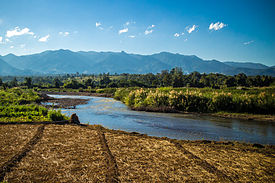| Pai River | |
|---|---|
 Pai River near Mae Hong Son | |
 Map of the Thai highlands | |
| Location | |
| Country | Thailand, Burma |
| State | Mae Hong Son Province (Thailand), Kayah State (Burma) |
| Physical characteristics | |
| Source | |
| • location | Daen Lao Range, Pai District, Mae Hong Son Province, Thailand |
| • coordinates | 19°27′0″N 98°29′20″E / 19.45000°N 98.48889°E |
| • elevation | 1,170 m (3,840 ft) |
| Mouth | Salween |
• location | Punghsa-se, Kayah State, Burma |
• coordinates | 19°08′45″N 97°32′40″E / 19.14583°N 97.54444°E |
• elevation | 111 m (364 ft) |
| Length | 180 km (110 mi) |
The Pai River (Thai: แม่น้ำปาย, Thai pronunciation: [mɛ̂ːnáːm paːj]; RTGS: Maenam Pai) is a river that originates in the mountains of the Daen Lao Range, Pai District, Mae Hong Son Province, Thailand. The river flows first in a north-south direction and then in an east-west direction down to Mueang Mae Hong Son District and across the Thai/Burmese border. The river tributes the Salween River in Kayah State, Burma. It is 180 kilometres (110 mi) long.
Its name in the Lanna language (![]() ) means "male elephant", comparable to the word "Plai" in the central Thai language. There is a story that in 1477 during the reign of King Tilokaraj, who was the ruler of Lanna Kingdom. He ordered his cousin Prince Si Chaiya to attack Ban Don. Meanwhile, one of his white elephants fled, he ordered the soldiers to find and found that it was swimming in this river.[1]
) means "male elephant", comparable to the word "Plai" in the central Thai language. There is a story that in 1477 during the reign of King Tilokaraj, who was the ruler of Lanna Kingdom. He ordered his cousin Prince Si Chaiya to attack Ban Don. Meanwhile, one of his white elephants fled, he ordered the soldiers to find and found that it was swimming in this river.[1]
Pai River is popular for whitewater rafting.[2] Rapids on the river vary from class I to class IV on the International Scale of River Difficulty and everything in between. Other than that The Pai River offers a scenic view of mountain forest and many choose to camp along the quiet river banks.
- ^ Deja, Ong-Arg (23 December 2006). ""ปาย" เปลี่ยนไป..." ["Pai" has changed...]. Prachatai (in Thai). Retrieved 7 September 2019.
- ^ "Rafting Along the Pai River". Tourism Thailand. Tourism Authority of Thailand (TAT). Archived from the original on 2 April 2015. Retrieved 16 March 2015.